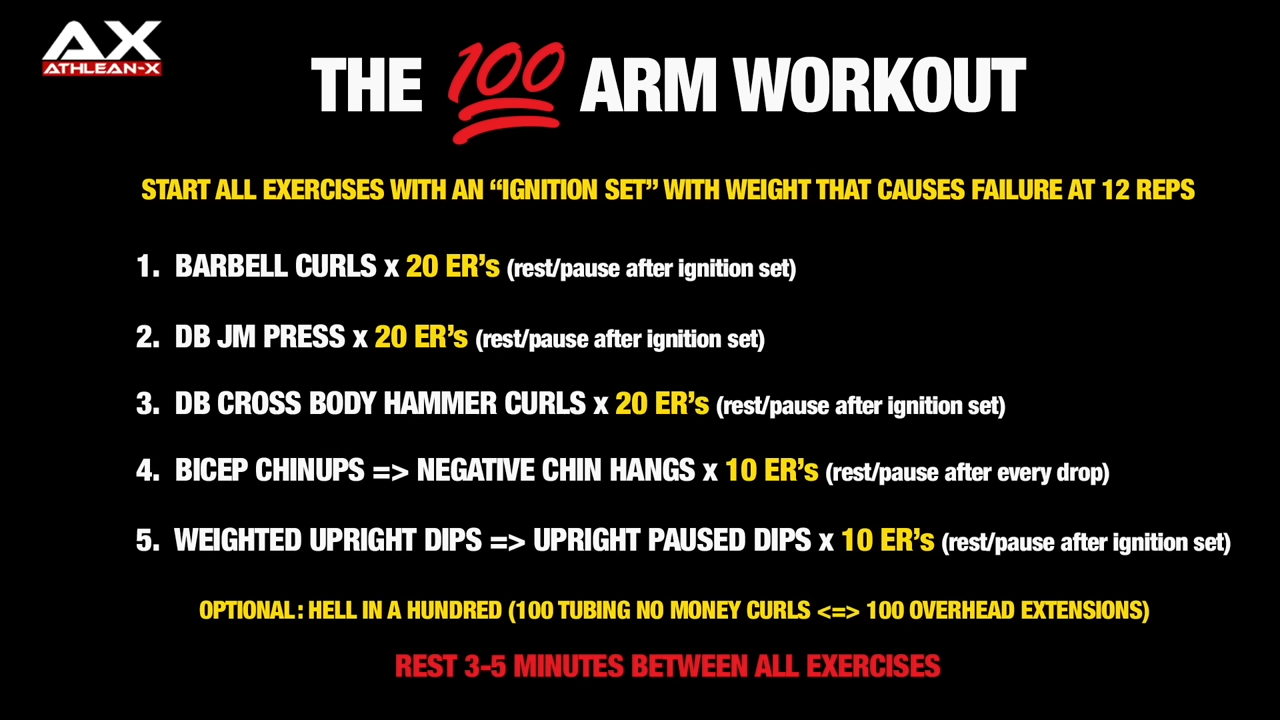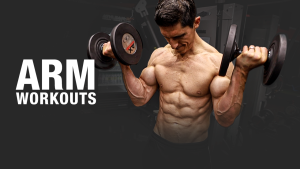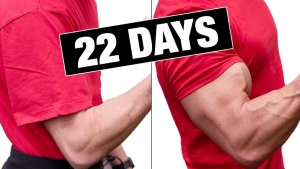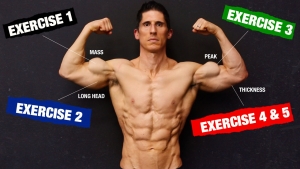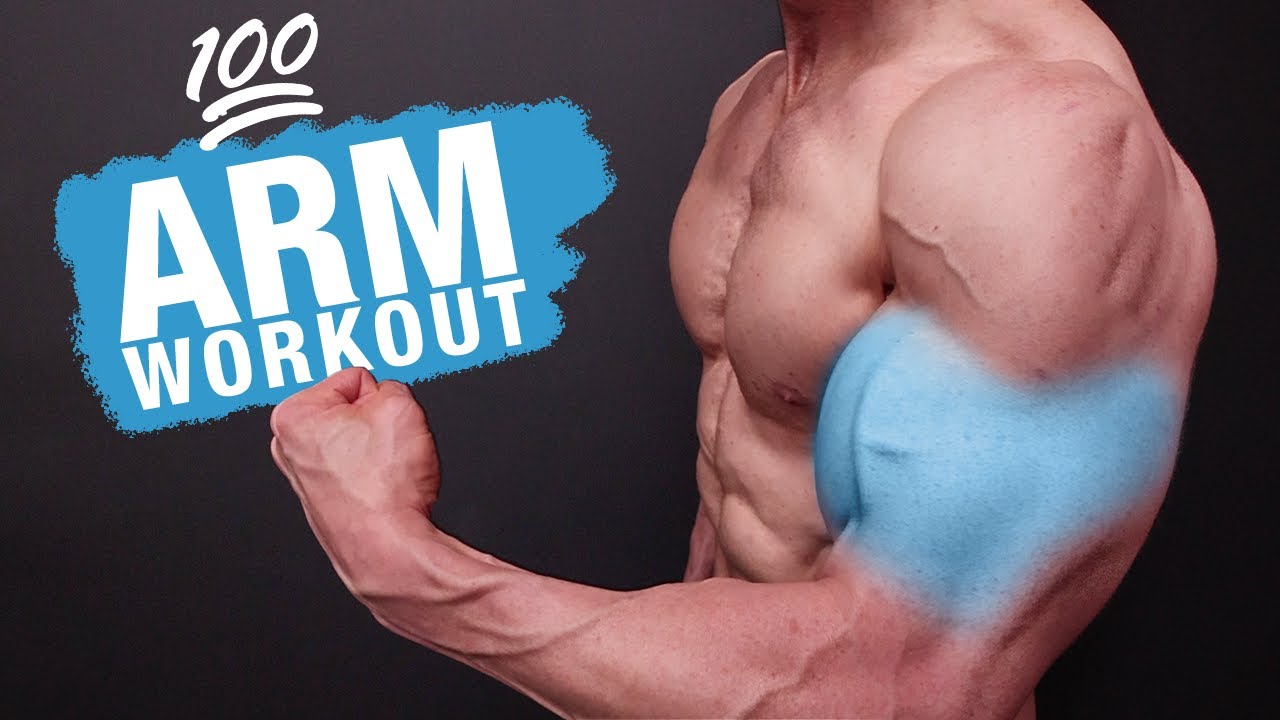
HOW TO BUILD BIGGER BICEPS & TRICEPS
Arnold himself has said that the most muscle growth can be attained in two key ways.
Doing high quality repetitions and making the last few reps count the most.
Spoiler alert: These are also some of the best drivers of muscle hypertrophy.
That means going through countless reps, trying to make every one of them count, only to find the real magic in the last three or so repetitions when you approach muscle failure.
Well, what if there’s a way for us to get to these reps faster with less energy and effort wasted?
Introducing the 100 Workout for biceps and triceps.
Guys, I promise you that this is the most effective arm workout you will ever do. And I know this because I’m going to make sure you focus on high quality effective reps.
Whether you want to fill out those sleeves or see some serious vascularity, this bicep and tricep workout is going to make that happen.
ANATOMY OF THE ARMS
You know the drill. Before we jump into the complete arms workout, I want to breakdown the anatomy of the tricep muscles and the bicep muscle.
There’s no doubt that forming a connection between your mind and muscles is critical for achieving maximum gains.
That’s why it’s essential to have an in-depth understanding of the muscle groups you are targeting with each exercise.
This is exactly what Arnold was talking about. You want to get your mind into the belly of the muscle. You want to be able to visualize how the muscle is working. Only then can you maximize your progress and results!
With that said, let’s jump into taking a closer look at the biceps muscle first.
THE BICEPS
The bicep muscle is aptly named BI-CEPS (bi meaning two) since it consists of two distinct heads.
This large and powerful double-headed muscle is responsible for elbow flexion, supination, and shoulder flexion as well.
BICEPS LONG HEAD

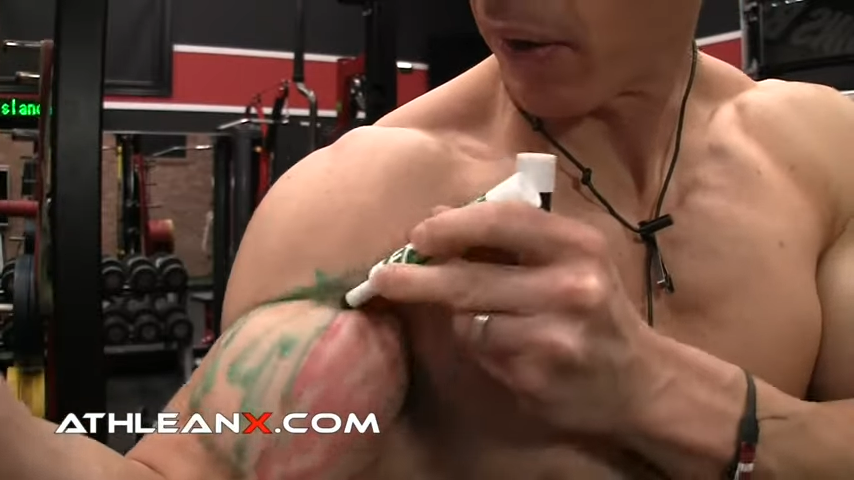
The biceps long head is situated to the outer portion of your upper arm and connects at your shoulder.
It plays a vital role in should flexion, allowing you to move with greater range of motion.
Although there is no single movement that solely targets and isolates the long head of the biceps, numerous exercises do predominately hit this muscle group.
For example, you’ll want to focus on biceps curl variations like the Hammer Curl, Cross-Body Curl, and Cross-Body Single-Arm Curl as these are particularly effective at building strength and mass in this region.
BICEPS SHORT HEAD

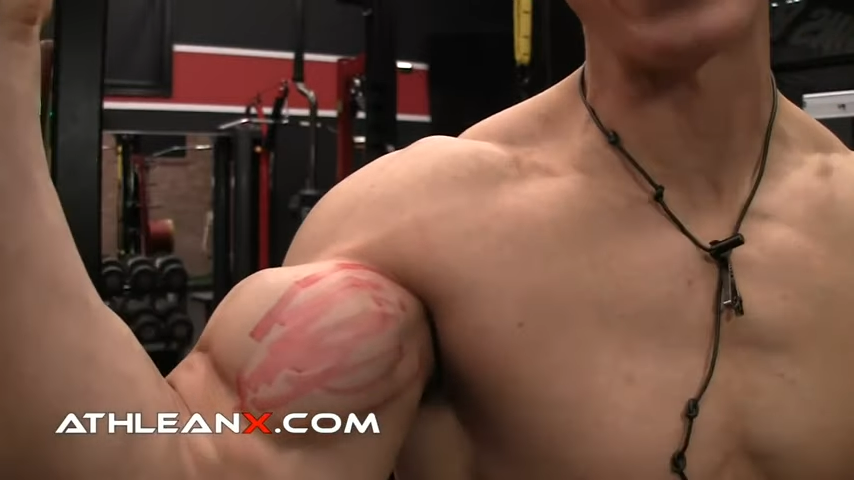
Look at the inside of your arm, to see the short head of the bicep muscle.
There are no specific exercises to isolate the short head of the biceps, but you can still focus on it more than its long head counterpart with certain bicep exercises.
Concentration Curls (Concentration Cable Curls), Barbell Preacher Curls, and Cheat Curls are all examples of fantastic exercises to add to your arms workout plan because they provide that extra emphasis for better results.
BRACHIALIS


We wrap up the biceps muscle section with the brachialis. Now technically, the brachialis isn’t part of what you would anatomically call the biceps.
However, it plays a vital role in creating an aesthetically pleasing arm even if it is not technically counted as part of the biceps.
More specifically, when you focus on building up the brachialis, you’ll notice that your arms look wider and thicker. You’ll see it most when you look in the mirror or if someone is looking at you from the front.
This is why I always include it when I’m discussing arm training and the best exercises per muscle group of the biceps.
THE TRICEPS
Now we move on to the other side of the upper arm with the triceps muscle.
The triceps brachii is a muscle with three heads or sections. Depending on which exercise you perform, you’ll notice that certain exercises favor muscle activation in one head more than the other two heads of the muscle.
LATERAL HEAD

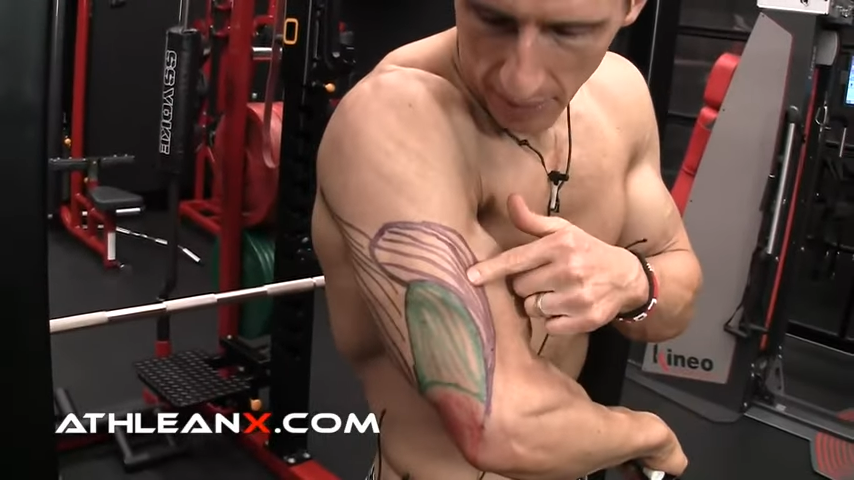
Located near the biceps brachialis, the lateral head of the triceps plays an essential role in elbow extension.
If you want to target the lateral head a little more than the other sections of the tricep muscle fibers, perform Dumbbell Triceps Extensions.
MEDIAL HEAD

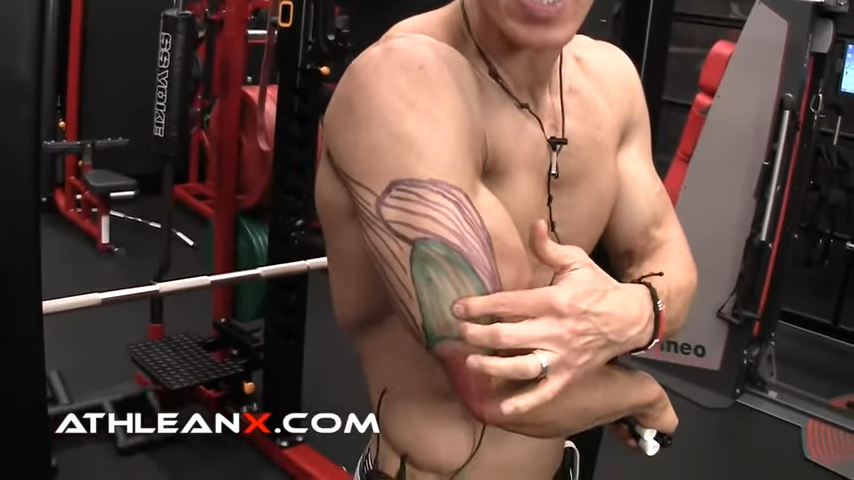
The medial head of the triceps not only plays a major role in elbow extension, but also helps with forearm extension.
Try the Cable-Rope Tricep Extension to target the medial head more than the other sections of the muscle fibers.
LONG HEAD

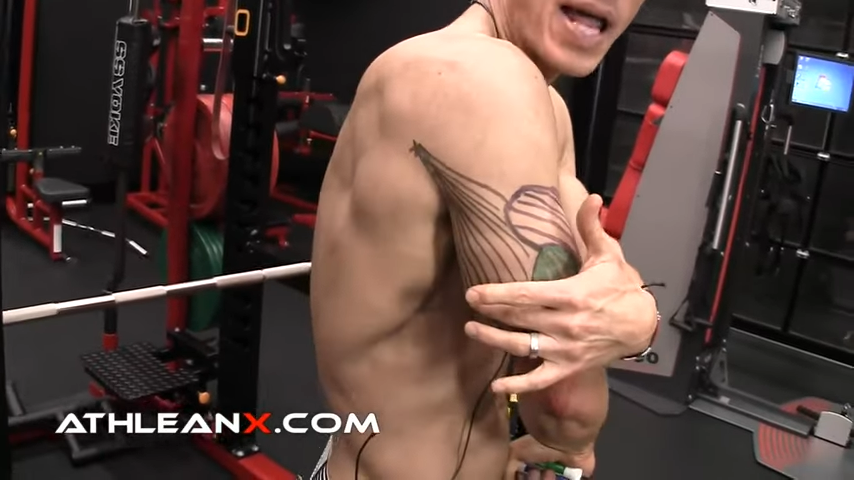
The triceps long head, extending over the shoulder joint, significantly contributes to arm adduction and extension. Furthermore, it serves as a stabilizing agent for elbow flexion.
This one section of the triceps makes up more than half of the muscle mass of your upper arm – More than half!
If you want to achieve that impressive arm size like Arnold had, then targeting the long head of your tricep muscles is a must.
Triceps exercises like the Tricep Kickback, Barbell Lying Triceps Extension (Skull Crushers), and Barbell Standing Triceps Extension are all great for targeting the long head of the muscle.
THE FOREARMS
Let’s move on to what I believe is the most neglected part of the arms workout plan: .
BRACHIORADIALIS

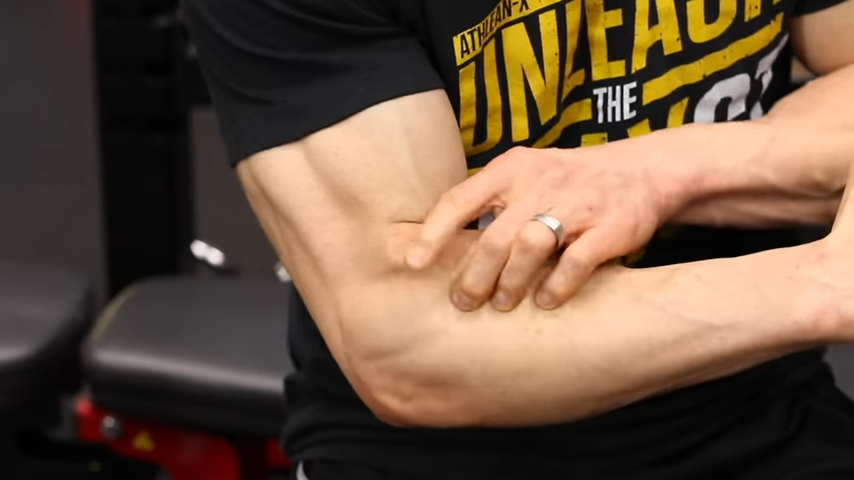
Originating from the humerus, the brachioradialis runs along the thumb side of your forearm and does not cross over to affect movement at your wrist joint.
Put simply, this means that unlike other muscles in your arm, it will not extend or flex movement there.
As a result, its role is limited mainly to providing stability and maintaining posture during activities such as gripping objects with greater force than normal.
FLEXORS AND EXTENSORS
Rather than solely focusing on the muscles, I believe it is more vital to consider the forearms’ functions when evaluating flexors and extensors.
The forearm muscles are involved in five distinct movements:
- ULNAR DEVIATION: The shifting of the pinky finger toward the outer side of the forearm.
- RADIAL DEVIATION: The movement of the thumb toward the inner aspect of the upper arm.
- WRIST FLEXION: The movement of the hand toward the wrist.
- FINGER FLEXION: The movement of your fingers toward the bottom of your hand.
- PRONATION: Close your hand like you did in finger flexion and then turn the closed hand toward the outside.
HOW TO NAVIGATE THIS ARMS WORKOUT
Before we jump into these exercises for strength training, I want to cover the format of the workout as well as how to perform “effective reps.”
All the 100 workouts in this series are based on what I like to call, “effective reps,” which involves pre-training before jumping into the actual set.
For this 100 Series workout, you’ll follow this training format for each exercise:
IGNITION SET
You’ll start with something I call the ignition set. This is where you’ll choose a weight that causes muscle failure around the 12-rep range.
This does not mean you should immediately go for lighter weights. Instead of picking up light weights, focus on a load where you are challenged but you can keep the weight under control for each and every repetition.
You should notice pretty quickly how easy the first few repetitions are because they should be. You are getting your muscle fibers ready for the real work that’s coming up next.
REST PAUSE
After you perform your 12 repetitions (or as close to it as you can), you’ll take your first rest pause, which should only last 15 seconds.
After 15 seconds, jump into your first set of effective reps.
EFFECTIVE REPS
It’s at this point that the actual workout begins. Your goal for the exercise is to perform 20 effective reps with the same weight from the ignition set.
Here’s the catch: The effective reps begin immediately.
You’ll see that the first set you perform after that ignition set is going to be instantly more challenging because the short rest pause.
What’s more, you’re able to tap into those type 2 muscle fibers faster.
Your goal is to perform 20 effective reps of the exercise. No, the ignition set does NOT count toward the effective reps.
Chances are, you won’t be able to perform 20 reps right after the ignition set and a very short break. Do as many as you can, which might only be five, and then go into a rest pause for 15 seconds.
REST PAUSE
The idea is to continue to chip away until you’ve reached all 20 of the effective reps on the exercise.
Even if you can only manage four or five solid reps with perfect form followed by a rest pause, that’s okay!
I want to see correct form for each and every one of these reps. Don’t worry about trying to get all 20 effective reps in one set. If you’re able to do that, you’re probably using a weight that’s too light.
EXTENDED BREAK
Once you complete all 20 effective reps of an exercise, rest for three-to-five minutes.
After this, move on to the next exercise.
100 SERIES: BICEP AND TRICEP WORKOUT
Ready to jump in and focus on the biceps and triceps in one of my favorite arm workouts?
Guys, this is important: Pick a weight that ensures muscular failure at around the 12-rep mark and do not forget the format of the workout I mentioned above. Here’s quick recap:
- Ignition set (~12 reps)
- Rest pause (15 seconds)
- Perform as many effective reps as you can get with proper form until you reach muscle failure
- Rest pause (15 seconds)
- Continue this pattern until you reach 20 effective repetitions for that exercise.
Once you complete 20 effective reps, rest for three to five minutes then move on to the next exercise in the series.
While there’s no time limit necessarily, this isn’t a typical 45-minute weights workout. You should be able to effectively crank this out in a time-efficient manner.
Which means, you really need to pay attention to the rest pauses you take. It’s just a quick 15-second break. That’s it!
With that said, don’t get too hard on yourself if it takes you longer, especially if you’re new to lifting. You’ll eventually get faster and more efficient with the moves.
Ready to get started? We begin this arms workout with the biceps and the Barbell Curl.
BARBELL CURL

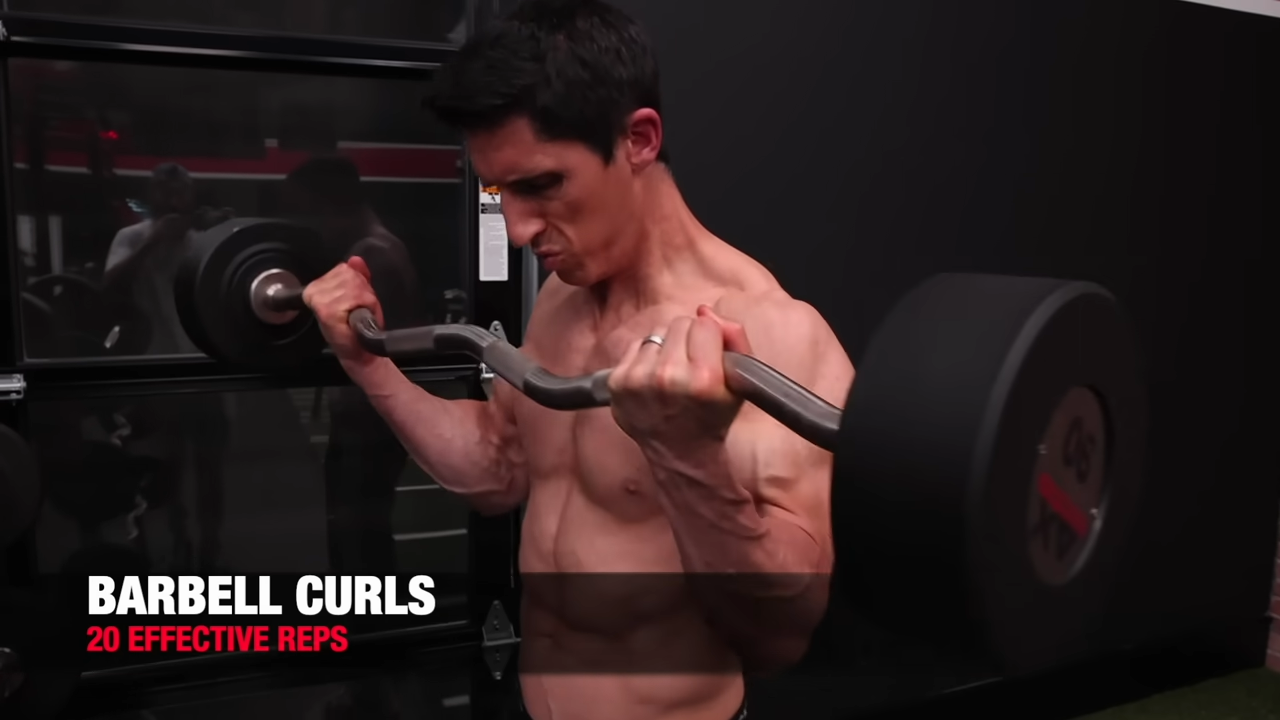
HOW TO DO THE EXERCISE: Stand with both feet placed hip-width apart. Using an underhand grip, firmly grasp an EZ Curl Bar with hands spaced around shoulder width. Keep your elbows close to the sides of your body for maximal control. Before you start, keep the core tight. This isn’t an ab workout, but it does require a bit of core strength, especially because you’re performing effective reps. Raise the barbell towards shoulder height, focusing on peak contraction at the top. Slowly lower the weight back down and repeat.
WHAT MAKES IT EFFECTIVE: This is an exercise for muscle growth and strength – plain and simple. The Barbell Curl allows you to go heavy and properly tax both heads of the biceps muscle.
DUMBBELL JM PRESS

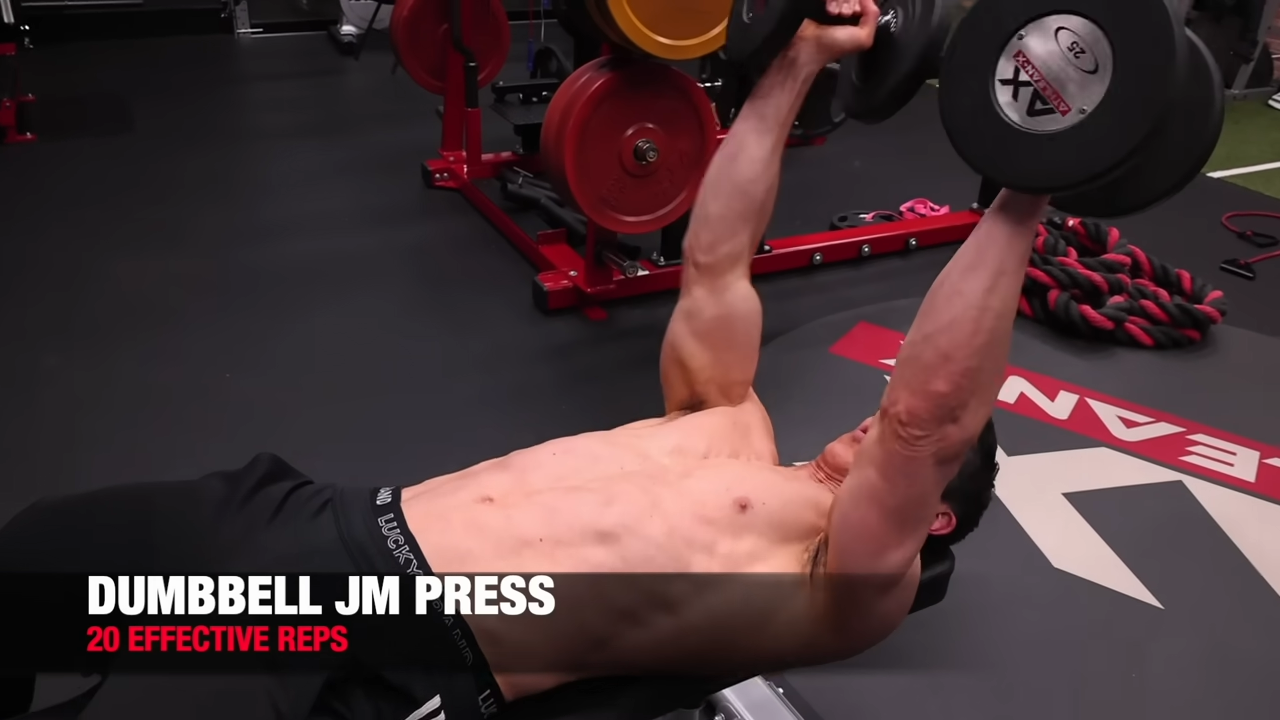
HOW TO DO THE EXERCISE: The second exercise focuses on the triceps. The starting position of the Dumbbell JM Press is on a flat bench with your feet flat on the floor. It’s very similar to Skull Crushers, but you don’t have to worry about the bar making contact with your face. Start with the dumbbells at your shoulders, extend the triceps to bring them forward and then push them straight up. Target your shoulders with the dumbbells and allow your elbows to drop and roll a little bit as you extend your arms up overhead.
WHAT MAKES IT EFFECTIVE: The JM Press is a great way to build up those triceps because it effectively recruits the long head of the triceps. It also includes a little bit of a pre-stretch on every repetition.
CROSSBODY HAMMER CURL

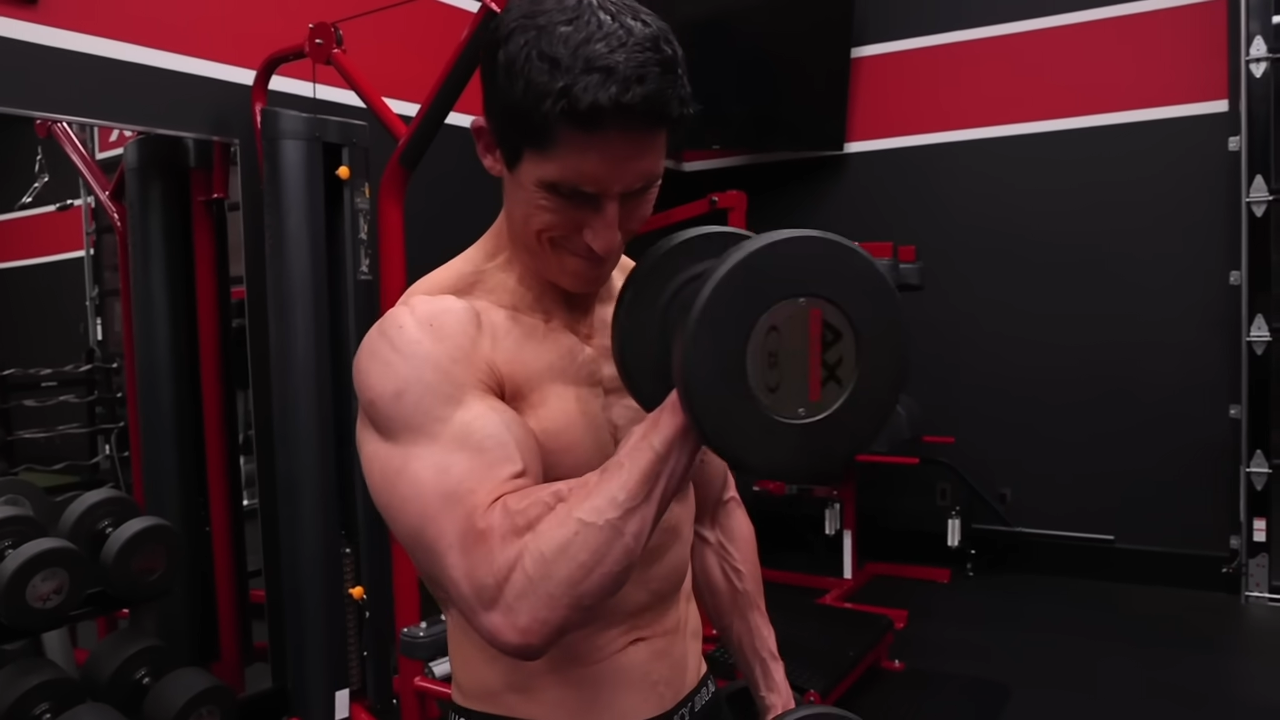
HOW TO DO THE EXERCISE: The Crossbody Hammer Curl is a one of the popular curl variants that primarily targets the key muscle, the brachialis. Instead of curling the weight straight up in front of your body, you cross it over to the opposite shoulder, which engages different muscle fibers in the biceps and forearms. Start by standing with your feet shoulder-width apart and holding a dumbbell in each hand, with your palms facing each other in a hammer grip, and your elbows close to your body. Keep your back straight, your shoulders relaxed, and your core engaged throughout the exercise. Curl the weight up towards your opposite shoulder by keeping your elbows close to your body and twisting your wrist so that your palms are still facing each other. Squeeze your biceps and hold the position for a second or two.
WHAT MAKES IT EFFECTIVE: This is one of my favorite Biceps Curl Variations because you can get more pronation than you would with a typical neutral grip Hammer Curl. Naturally, this will allow you to hit more of the brachialis and brachioradialis in the forearm and upper arm. Again, don’t just immediately go for a light dumbbell here. Go for a couple of dumbbells that challenge you but still allow you to fail around that 10 to 12 rep range.
TRICEPS PUSHDOWN

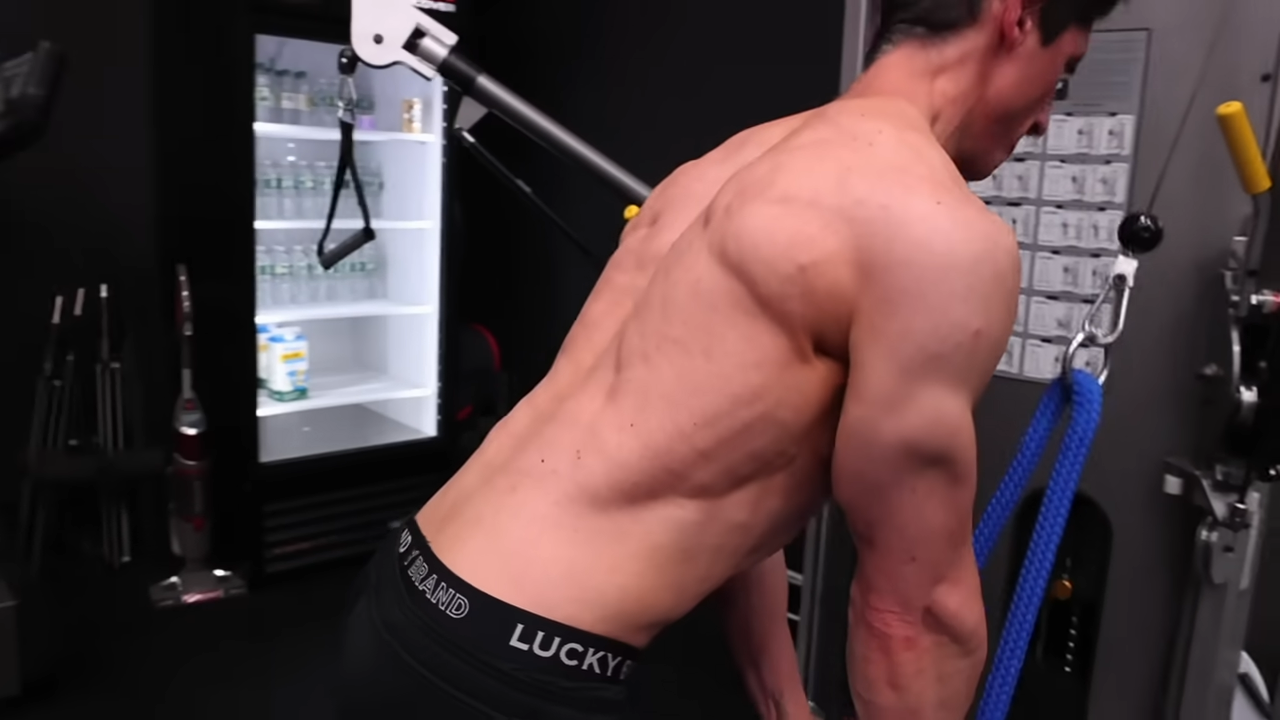
HOW TO DO THE EXERCISE: Start by standing facing a cable machine with a rope handle attached to the high pulley. Hold the rope with an overhand grip. Stand with your feet shoulder-width apart and your knees slightly bent. Keep your back straight and your core engaged throughout the exercise. Pull the rope down until your elbows are fully extended and your arms are straight. Keep your elbows close to your body and avoid swinging your arms or using momentum to lift the weight. Slowly release the weight back up to the starting position, with control.
WHAT MAKES IT EFFECTIVE: Unlike the JM Press, the Triceps Push Down is going to focus most of its effort on the lateral and medial heads of the triceps. With that focus, you really want to make sure that you’re getting full complete extension of the elbow on every single rep. Far too many times, I see people shortchange the extension that they get at the elbow.
BICEP CHIN-UP


HOW TO DO THE EXERCISE: Reach up and grab the bar with an underhand grip, with your palms facing towards you. Hang from the bar, keeping your core tight and your shoulders down. Bend your elbows and squeeze your biceps muscles to bring yourself up. Put some distance between yourself and the bar to focus on the bicep muscles. Keep your elbows close to your body and avoid swinging your legs or using momentum to lift your body. Once your chin is above the bar, pause for a second or two and hold the position.
WHAT MAKES IT EFFECTIVE: The difference between this and a regular Chin Up is just simply the angle of the elbow. When you’re performing the Biceps Chin-Up, open up that distance a little more. Create more of a 90-degree angle at your elbow as you perform the exercise to ensure that more of the focus is on the biceps and less of it is on the lats. This is what makes this an effective biceps building exercise.
WEIGHTED UPRIGHT DIP

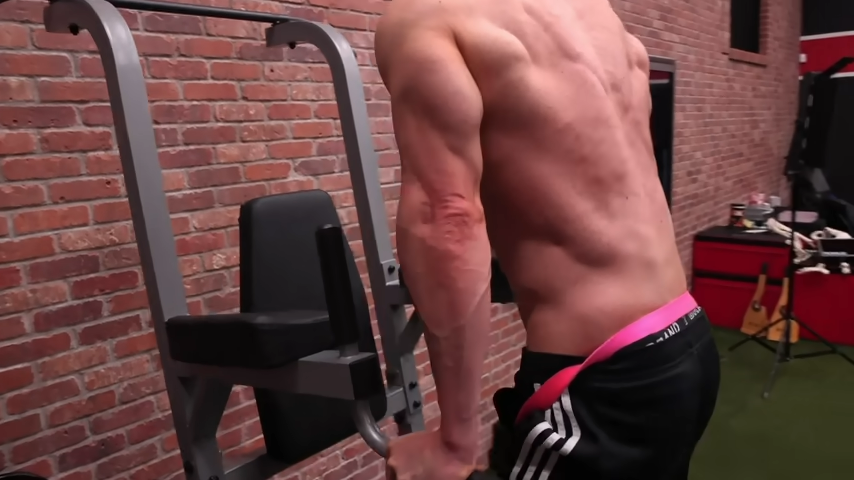
HOW TO DO THE EXERCISE: Before you begin, set up a weight belt around your waist with a weight plate securely fastened. Start by standing between two parallel bars or a dipping station with your hands on the bars and your palms facing inward. Keep your core engaged and your back straight throughout the exercise. Lower your body down towards the bars by bending your elbows, keeping your chest up and your shoulders down. Stop when your elbows are at a 90-degree angle and your upper arms are parallel to the ground. Push your body back up to the starting position by straightening your arms, squeezing your triceps muscles and keeping your core engaged.
WHAT MAKES IT EFFECTIVE: This exercise allows you to perform effective drop sets to ensure the muscle is completely fatigued. As always, be sure to focus the contraction in the triceps muscle.
FINISHERS: HELL OF A HUNDRED
Once you complete 100 total reps of the exercises above – 50 for the biceps and 50 for the triceps – it’ll be time to finish strong with something I like to call Hell of a Hundred.
This is going to be different from the format above because there will be NO breaks.
Instead, you’ll perform 20 reps of the Banded Bicep Curl exercise followed immediately by 20 reps of the Overhead Tricep Extension.
From here, all you’re going to do is go back and forth between the two exercises until you reach 100 reps for each.
As I mentioned, there is no specific rest between exercises.
Rather, you’ll be able to rest your biceps while you’re working on your triceps and vice versa.
Despite the other exercises, you should be able to blow through these pretty quickly given the resistance of the load.
Still, this is going to be a challenge, especially because I want you to focus on the eccentric movement of the exercises.
You need to keep bringing it because you’re almost finished with the workout, so finish up strong.
BANDED BICEP CURL


HOW TO DO THE EXERCISE: Start by standing on the center of the resistance band with your feet shoulder-width apart. Hold the ends of the band with an underhand grip, with your palms facing up and your hands shoulder-width apart. Keep your elbows close to your body and your shoulders relaxed throughout the exercise. Curl the band up towards your shoulders by bending your elbows and squeezing your biceps muscles. Keep your wrists straight and avoid bending them during the exercise. Squeeze your biceps at the top of the movement and hold the position for a second or two. Slowly release the band back down to the starting position, with control.
WHAT MAKES IT EFFECTIVE: Using bands is a form of variable resistance training, and one of the best things about this is the constant tension on the muscle. Move slow and your arms are going get an insane pump from the high reps.
OVERHEAD TRICEPS EXTENSION

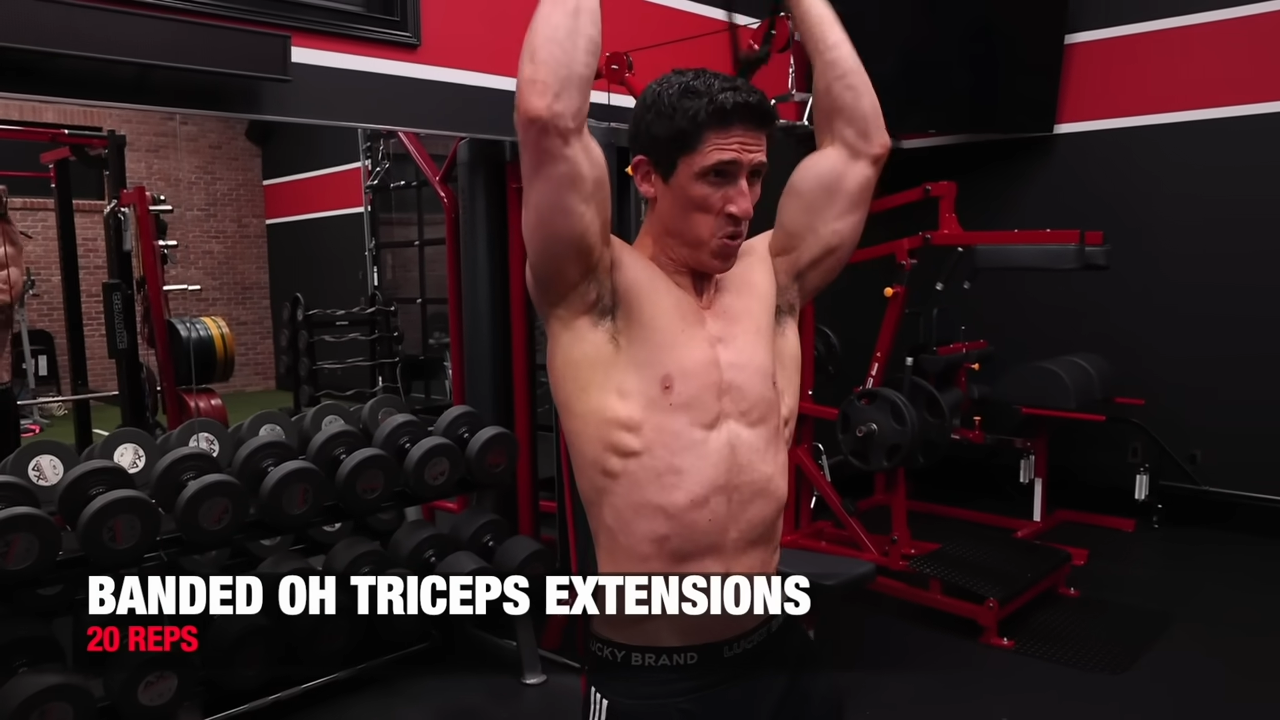
HOW TO DO THE EXERCISE: Start by standing on the center of the resistance band with your feet shoulder-width apart. Hold the ends of the band with an overhand grip, with your palms facing up and your hands shoulder-width apart. Raise your arms overhead with your elbows close to your head and your wrists straight. Keep your core engaged and your shoulders relaxed throughout the exercise. Lower the band down behind your head by bending your elbows and keeping your upper arms close to your head. Keep your elbows close to your head and avoid swinging your arms or using momentum to lift the band. Squeeze your triceps muscles at the bottom of the movement and hold the position for a second or two. Slowly raise the band back up to the starting position, with control.
WHAT MAKES IT EFFECTIVE: Just like with the Banded Curls, this exercise is going to produce a constant tension in the muscle, allowing you to achieve true muscular failure and get a hell of a pump doing it.
When designing a workout routine that includes both biceps and triceps exercises, it’s important to choose a variety of exercises that target each muscle group from different angles and with different ranges of motion.
It’s also important to use proper form and to gradually increase the weight and intensity of your workouts over time to avoid injury and ensure continued progress.
Guys, if you want to see a big difference in your arm strength, size, and development, I want to challenge you to incorporate this 100 Series workout into your compound moves program.
Give it a try for at least four weeks and then let me know what gains you made.
If you don’t already have a program, I can help out with that! Check out our ATHLEAN-X programs to see which one best fitness your goals and fitness level!

- If you look at most arm workouts people perform, they usually consist of the same arm exercises. The issue isn’t necessarily what exercises you’re doing but how you’re doing them.
- In order to increase the intensity of the workouts you are doing, you have to focus on increasing the intensity of each set you perform.
- Consider that in a normal set of 12 reps that only the last two-to-three reps are actually hard enough to provide enough stimulus for muscle growth. That’s a lot of wasted energy!
- Instead of doing the traditional method, I want you to incorporate two things into your arm training: ignition sets and rest pauses. By doing so, you are instantly back to recruiting more type II fibers, which are able to respond to your hard work in the form of new size. Here’s how to transform your arm workouts:
- Perform a set of the recommended biceps or triceps exercise to 12 repetition failure. This is called the ignition set.
- At this point, the real work begins. Rest for just 15 seconds as part of your rest/pause. As soon as these 15 seconds are up, get back into another set using the same weight.
- Perform as many reps as you can, then move into a rest/pause. These are all “effective reps.” Each bout should be taken to failure.
- Accumulate 20 effective reps (or in some cases, 10 reps), even if you’re getting just one out at a time until your work on that exercise is complete.
- Once you complete all 20 effective reps of an exercise, rest for three-to-five minutes then move on to the next exercise.
BICEP AND TRICEP WORKOUT FAQS
Yes, you can definitely work out biceps and triceps together in the same workout session. In fact, training both muscle groups together can be an effective way to maximize your time in the gym and achieve better overall upper body strength and muscle development.
One of the main benefits of training biceps and triceps together is that they are opposing muscle groups, meaning that when one muscle group is working, the other is resting. This allows you to perform supersets or circuits where you alternate between biceps and triceps exercises with little to no rest in between, which can help you save time and increase the intensity of your workout.
Another benefit of working out biceps and triceps together is that it can help you achieve a balanced and proportionate upper body. While biceps are responsible for flexion of the elbow, triceps are responsible for extension of the elbow. By working both muscle groups together, you can ensure that your upper arm muscles are equally developed, which can improve your overall strength and aesthetics.
Continuing with the point above, yes, you should train the biceps and triceps together on the same day, but only if it makes sense to your fitness goals.
What are you trying to accomplish with your workout? What do you want your physique to look like?
If you’re already using a Push-Pull split, for example, does it make sense to remove the arm exercises to their own day?
This is something only you can answer based on your fitness goals and experience. With that said, I highly recommend training the biceps and triceps together.
It saves time, ensures the arms are developed in a balanced way, and produces an incredible pump!
Here are some examples of biceps and triceps exercises that can be done together in the same workout:
- Biceps Curls and Triceps Dips
- Hammer Curls and Overhead Triceps Extensions
- Chin-Ups and Close-Grip Push-Ups
- Preacher Curls and Triceps Kickbacks
When designing a workout routine that includes both biceps and triceps exercises, it's important to choose a variety of exercises that target each muscle group from different angles and with different ranges of motion.
It's also important to use proper form and to gradually increase the weight and intensity of your workouts over time to avoid injury and ensure continued progress.
REFERENCES

Jeff Cavaliere M.S.P.T, CSCS
Jeff Cavaliere is a Physical Therapist, Strength Coach and creator of the ATHLEAN-X Training Programs and ATHLEAN-Rx Supplements. He has a Masters in Physical Therapy (MSPT) and has worked as Head Physical Therapist for the New York Mets, as well as training many elite professional athletes in Major League Baseball, NFL, MMA and professional wrestling. His programs produce “next level” achievements in muscle size, strength and performance for professional athletes and anyone looking to build a muscular athletic physique.


















